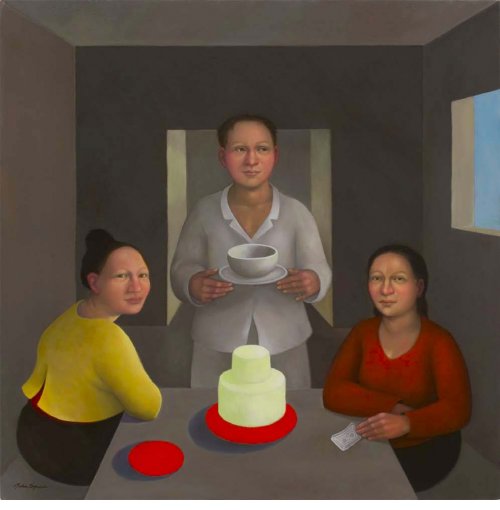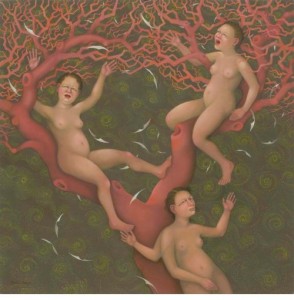With so much contemporary figuration built on photography, it is refreshing to meet a painter who puts away the camera. Julie Speed is as much a showman as a painter; the inscrutability and frequent magic of her compositions makes the camera irrelevant.
Born in Chicago in 1951, Speed is a lifelong lover of drawing, an evident fact that likely contributed to her impatience with art school. She dropped out early on and makes no bones about it. After a string of oddball jobs, she landed in Austin, Texas, in 1978. As she tells it, she threw herself into studio life and spent the next thirty years teaching herself to paint. The wife of drummer Fran Christina, she gained national recognition when the three-eyed figure of her Setting the World on Fire appeared on the cover of Grammy-award winner Shawn Colvin’s A Few Minor Repairs.
That third eye plus other anatomical oddities—a missing digit on a ring finger or two, an extra arm here and there—reappear in this show, her third at Gerald Peters in New York. A catchy album cover, however, is one thing; an enduring image is something else. Playful appropriation (from Bosch, folk art, Mantegna, Cranach, you name it) only goes so far. But when Speed transcends fey urges to idiosyncrasy, she produces marvelous, enigmatic compositions.
Take, for example, Yellow Cake (2009). An oil no more that 18 inches square, it approaches monumentality in its uncluttered forms and austere geometric staging. A formal trio composed of a standing man and two seated women surround a luminous cake, its rounded perfection consistent with the solid masses around it. How formidable—and delicious—her use of color is here. Beautifully nuanced warm grays in the background set off cool silvery tints on the man’s clothing. A subdued table top sets vermilliion plates aglow.
Their spectrum heat is balanced and controlled by the variegated yellow of a woman’s blouse on one side and the reticent deep red of the other.

The women look directly at the viewer; the man, facing front, turns his eyes away. His glance off-stage signals uneasiness. The subtlety of it is more convincing and effective than obvious attempts at disquiet that appear elsewhere (i.e. bees dotted across the canvas of Hive).
Speed is a sophisticated and fastidious painter. The pose of the self-taught artist provides cover for hollow intention.
Her faux-naif persona permits great leeway to frolic, but it comes at a price. Oddity for its own sake is entertaining but ultimately aimless. Speed is capable of something larger, if she wants it.
Herewith, an oddity:

Outside the gallery on the night of the opening, a well-dressed group of gallery clients clustered around one beautifully tailored older man who was tutoring the others in what to look for in a painting. He said of Speed’s work,” This is great painting! You can’t see a single brush stroke!” With criteria like that working against them, most of the finest painters around might as well close up shop and sell walnuts.
© 2010 Maureen Mullarkey


